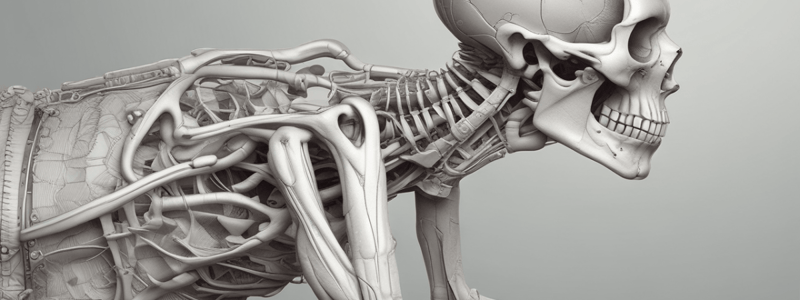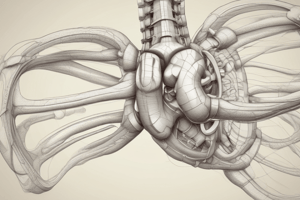Podcast
Questions and Answers
What is the degree of rotation required for micro failure of annular fibers?
What is the degree of rotation required for micro failure of annular fibers?
- 2.5 degrees
- 5 degrees
- 10 degrees
- 3 degrees (correct)
What is the purpose of the facets in the lumbar spine?
What is the purpose of the facets in the lumbar spine?
- To protect the intervertebral discs from rotational stresses (correct)
- To facilitate flexion in the lumbar spine
- To provide additional support for the posterior annular fibers
- To increase rotational range of motion
What is the typical degree of rotation allowed by the articular cartilage before compression occurs?
What is the typical degree of rotation allowed by the articular cartilage before compression occurs?
- 3 degrees (correct)
- 5 degrees
- 1 degree
- 2 degrees
What is the typical location of an intervertebral disc herniation that causes Cauda Equina Syndrome?
What is the typical location of an intervertebral disc herniation that causes Cauda Equina Syndrome?
What is a red flag for Low Back Pain that requires surgical attention?
What is a red flag for Low Back Pain that requires surgical attention?
What is the degree of rotation that causes complete macro failure of annular fibers?
What is the degree of rotation that causes complete macro failure of annular fibers?
What is a musculoskeletal cause of Low Back Pain?
What is a musculoskeletal cause of Low Back Pain?
What is the percentage of compression required for the articular cartilage to allow 3 degrees of rotation?
What is the percentage of compression required for the articular cartilage to allow 3 degrees of rotation?
What is the most common cause of lumbar strain/sprain?
What is the most common cause of lumbar strain/sprain?
What is the primary purpose of imaging in lumbar strain diagnosis?
What is the primary purpose of imaging in lumbar strain diagnosis?
What is the effect of prolonged bedrest on recovery from lumbar strain?
What is the effect of prolonged bedrest on recovery from lumbar strain?
What is the characteristic of facet pain?
What is the characteristic of facet pain?
What is the most common cause of lumbar radiculopathy?
What is the most common cause of lumbar radiculopathy?
What is the significance of dermatomes in lumbar radiculopathy?
What is the significance of dermatomes in lumbar radiculopathy?
What is the characteristic of myotomes in lumbar radiculopathy?
What is the characteristic of myotomes in lumbar radiculopathy?
What is the implication of HVLA in lumbar radiculopathy?
What is the implication of HVLA in lumbar radiculopathy?
What is the effect of chemical changes on nerve root irritation?
What is the effect of chemical changes on nerve root irritation?
What is the relationship between herpes varicella and shingles?
What is the relationship between herpes varicella and shingles?
What is the position of the sacrum with less lordosis and facets spread apart?
What is the position of the sacrum with less lordosis and facets spread apart?
Which of the following is a sign of a PI ilium?
Which of the following is a sign of a PI ilium?
What is the percentage of lower back pain caused by SI issues?
What is the percentage of lower back pain caused by SI issues?
What is the effect of a compression test on a patient with PS-SB?
What is the effect of a compression test on a patient with PS-SB?
Which of the following is a palliative maneuver for SI Syndrome?
Which of the following is a palliative maneuver for SI Syndrome?
What is the effect of a compression test on a patient with AI-SB?
What is the effect of a compression test on a patient with AI-SB?
Which of the following is a sign of a AS ilium?
Which of the following is a sign of a AS ilium?
What is the position of the sacrum with more lordosis and facets approximate?
What is the position of the sacrum with more lordosis and facets approximate?
What is the primary function of the muscles innervated by L3?
What is the primary function of the muscles innervated by L3?
Which of the following is a visceral cause of low back pain?
Which of the following is a visceral cause of low back pain?
What percentage of patients with malignant spinal neoplasms are over 50 years old?
What percentage of patients with malignant spinal neoplasms are over 50 years old?
Which of the following is a red flag for cancer?
Which of the following is a red flag for cancer?
What is the most common source of spinal malignancy?
What is the most common source of spinal malignancy?
What is an absolute contraindication to HVLA?
What is an absolute contraindication to HVLA?
What is the definition of a contraindication?
What is the definition of a contraindication?
What is the definition of an adequate reaction?
What is the definition of an adequate reaction?
What is the definition of an adverse reaction?
What is the definition of an adverse reaction?
What is the most common compression fracture seen in patients with osteoporosis?
What is the most common compression fracture seen in patients with osteoporosis?
Flashcards are hidden until you start studying
Study Notes
Lumbopelvic Biomechanics
- The sacrum has two positions: open-packed and closed-packed
- Open-packed position:
- Less lordosis
- Facets spread apart
- Disc more vulnerable to damage
- MC disc herniation occurs when in flexion + rotation
- Closed-packed position:
- More lordosis
- At risk for facet syndrome
- Sacral compression test:
- Gentle pressure on SB: P->A
- Relieves pain if PS-SB
- Increases pain if AI-SB
- PI ilium:
- More common
- Signs:
- Low crest & PSIS/ High ASIS
- Short leg
- Decreased prone thigh extension
- Prominent PSIS
- AS ilium:
- Signs:
- High crest & PSIS/ low ASIS
- Long leg
- Increased prone thigh extension
- Less prominent PSIS
- Signs:
SI Syndrome
- Provocative (increases pain):
- Weight-bearing
- Sit -> stand
- Walking
- Palliative (decreases pain):
- Laying down
- Findings:
- Pain from SI joint
- Local tenderness
- Leg-length inequality
- Lig. laxity
- Hypomobility
- Guarded gait, compensatory mechanisms
Lumbar Joints and Pathology
- Rotational ROM:
- 10-15 degrees
- 2.5 degrees per joint
- Articular cartilage must compress 60% to allow 3 degrees of rotation
- >3 degrees of rotation -> micro failure of annular fibers
- 12 degrees of rotation -> complete macro failure of annular fibers
- Facets:
- Protect IVD from rotational stresses
- In flexion, facets spread out
- Disrupts posterior annular fibers
- Disruption greater with rotation
- Cauda Equina Syndrome (CES):
- Caused by midline IVD herniation @ L3, L4, or L5
- Signs:
- Bilateral radiculopathies
- Distal paralysis of lower limbs
- Sacral sensory loss
- Sphincter paralysis
Causes of LBP
- Red flags for LBP:
- Unsteady when standing/ walking
- Difficulty passing or controlling bladder/ bowels
- Previous cancer or osteoporosis
- LBP with unexplained weight loss/ fever
- Musculoskeletal:
- Musculo-lig. injuries
- MC cause = lumbar strain/ sprain
- Chronic strain/ sprain MC caused by faulty biomechanics of weak muscles
- IVD/ facet degeneration
- Degeneration can lead to root impingement through IVF
- Facet hypertrophy
- Herniated disc into IVF
- Nerve root irritation
- Causes:
- Direct mechanical pressure
- Chemical changes
- Spinal stenosis (narrowing)
- Viral infection
- Causes:
- Musculo-lig. injuries
- Visceral:
- Can refer LBP from abdominal & pelvic organs
- e.g. gallstones, kidney stones, aorta, lymph nodes
- Systemic:
- Cancer
- MC systemic disease affecting spine
- Only accounts for 50 y/o
- History of cancer
- Red flags:
- Unexplained weight loss
- Pain > 1 month w/o improvement to conservative therapy
- Pain not better w/ rest
- Spinal infection
- Absolute contraindication to HVLA
- Osteomyelitis
- Septic discitis
- Spinal TB
- Red flags:
- History of UTI, catheters, skin infections, injection sites, IV drug users
- Fever
- Compression fractures
- MC in pt w/ osteoporosis
- Red flags:
- Osteoporosis
- Corticosteroid usage
- >50 or >70 y/o
- Hx of trauma
- Cancer
Contraindications
- Definitions:
- Contraindication:
- Problem identified before the procedure
- Absolute contraindication
- Contraindicative to ANY form of thrust manipulation
- Relative contraindication
- Potential contraindication depending on severity/ stage
- Complications:
- Problem that occurs after procedure performed
- Reversible complication
- Pathological condition that is reversible
- Onset within 2 days
- Tissue damage but can be reversed
- Irreversible complication
- Onset within 2 days
- Permanent tissue damage
- Reaction:
- Episodes of increased symptoms that resolve spontaneously
- Normal reaction
- Minor increase in discomfort
- MC in pt w/ successful treatment
- Adverse reaction
- Significant discomfort
- Least common
- Adequate reaction
- Normal product of manual therapy
- Onset 6-12 hours
- Local soreness, tiredness, headache
- No decrease in work, ADL's
- Duration
- Contraindication:
Studying That Suits You
Use AI to generate personalized quizzes and flashcards to suit your learning preferences.




